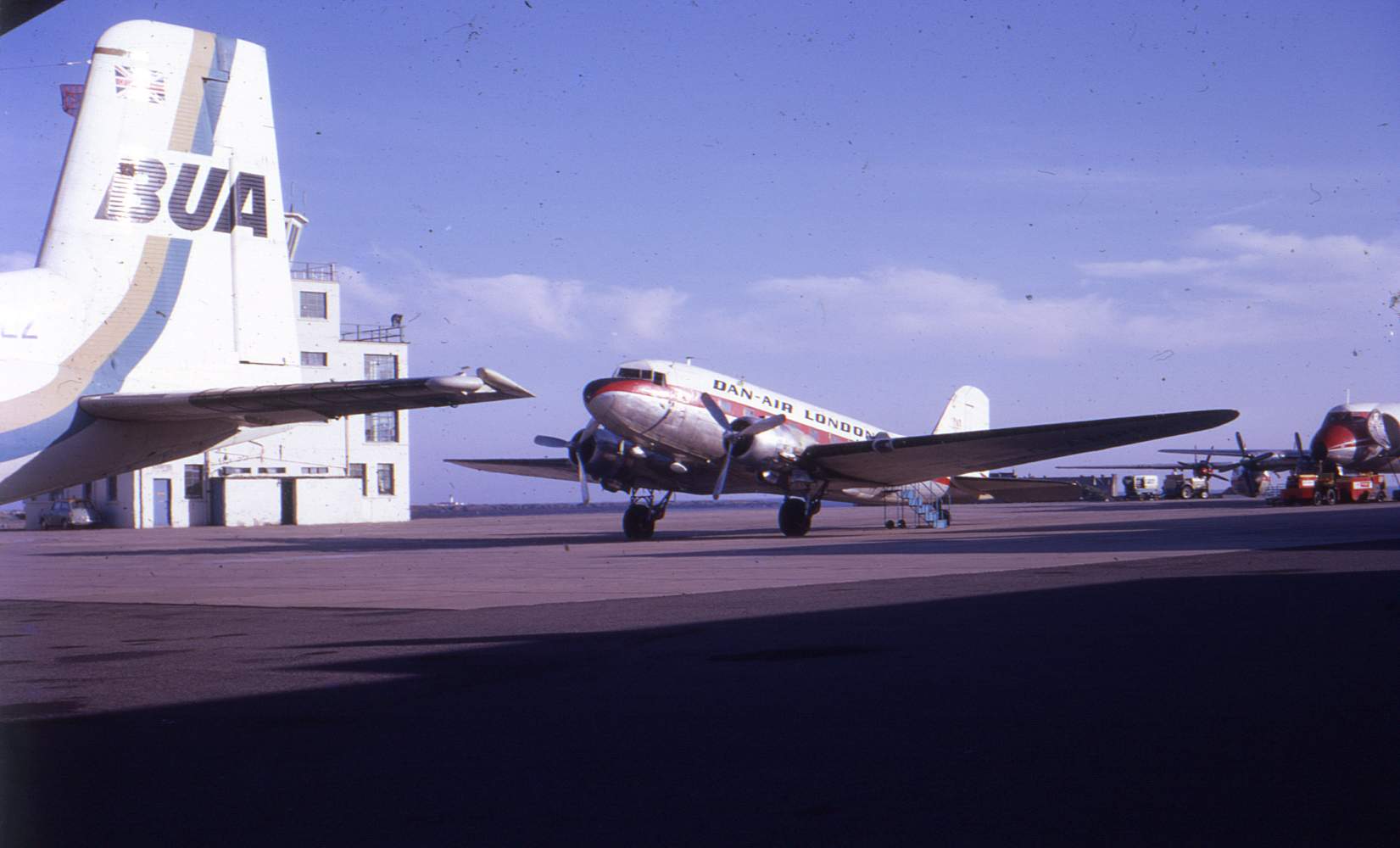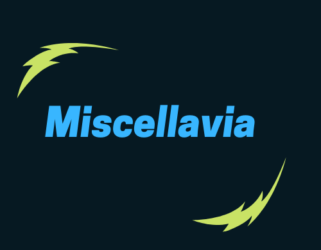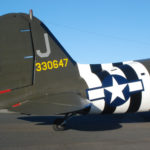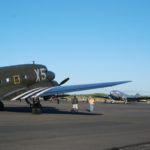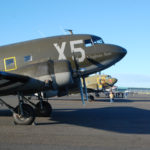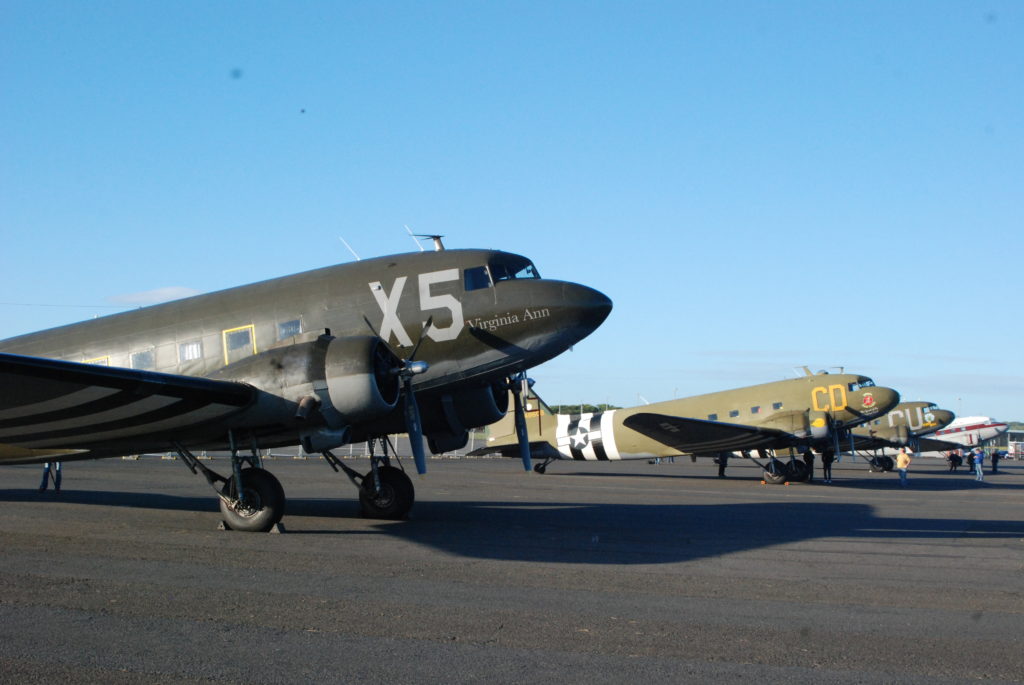
Virginia Ann is one of the D-Day Squadron aircraft carrying the name which she used back in 1944. Named after the Pilot’s wife, Virginia Ann Shoemaker, she took part in D-Day, Market Garden and the Rhine Crossing flying both American and British troops from bases in England. She is also a girl who knows how to make an entrance! The last to arrive of the eight Dakotas on display at Prestwick in May 2019, she landed a few minutes after the Friday night photo evening was due to start. Promptly taxiing to the parking area, camera shutters clicking everywhere, she was swiftly parked-up and visitors were able to stroll around appreciating the smell of hot radial and Avgas. The following day, visitors were able to board the C-47 and experience the spartan surroundings fourteen paratroops would have travelled in on D-Day (1).
C-47A-DL, construction number 13798 rolled-off the Long Beach production line as 43-30647, part of contract # AC-20669 for the USAAF. When Douglas’s new factory at Oklahoma City came on-line, there was some confusion with construction numbers which ended-up with over 130 aircraft having exactly the same serial as an aircraft built at Long Beach. This error was later cleared-up by the renumbering of Oklahoma aircraft – however, there was originally another 13798 which was subsequently allocated the construction number 25243/ 13798. Virginia Ann was delivered on September 21st 1943 and initially assigned to 12th Air Force on 16th January 1944 (2).
During 1943, the 12th Air Force had been involved in the Mediterranean theatre of operations along with the 9th Air Force. Following the airborne assaults on Sicily and mainland Italy during the summer and autumn of ’43, parts of 12th Air Force and the 9th had been amalgamated. The transport and medium bomber groups were transferred to England during early 1944 prior to the D-Day landings and were placed under control of 9th Air Force. Paratroop and glider operations were the responsibility of IX Troop Carrier Command. Virginia Ann was allocated to 59th Squadron of 61st Troop Carrier Group, itself a part of 52nd Troop Carrier Wing. She probably didn’t arrive on station until after the 61st TCG had arrived in England from Italy.
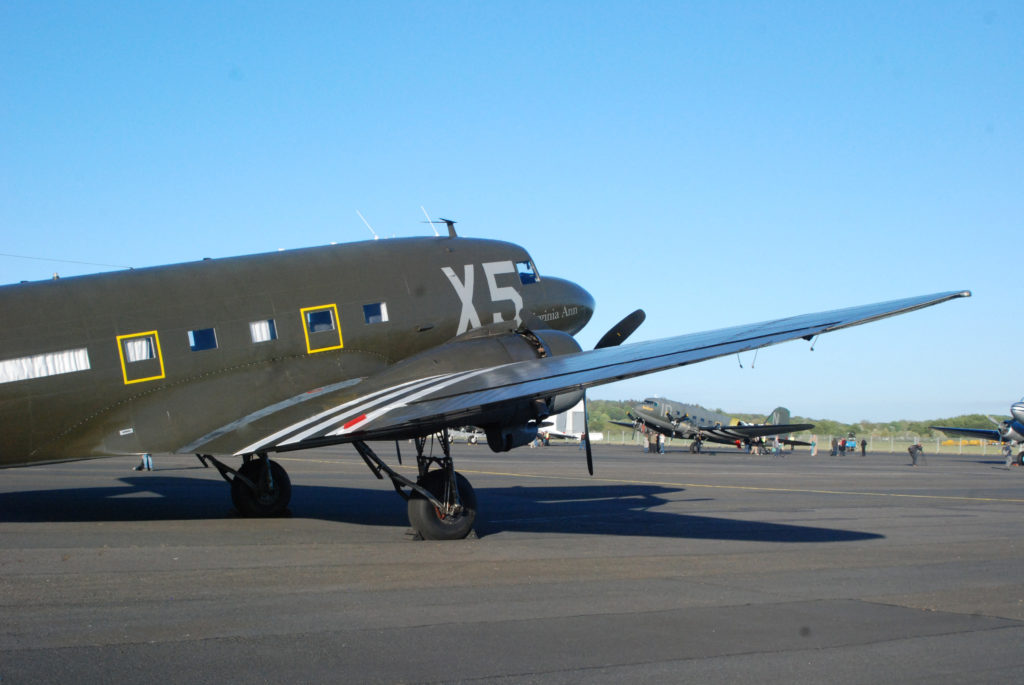
The 61st TCG, commanded by Texan Lt.Colonel Willis Mitchell, had been very active with 12th Air Force in the Mediterranean theatre in 1943 working eastwards from Casablanca to Tunisia before the ‘Husky’ landings in Sicily (3). At the end of 1943 they were based at Sciacca in Sicily but, in February 1944, the group began the transit to the UK. Lt. Colonel Mitchell departed Sciacca on 11th February followed by a 12 aircraft formation on the following day. They routed via Oran in Algeria to Morocco where they were delayed by poor weather. The 13-hour long over-water transit to the UK required the fitment of extra fuel tanks. Some aircraft were fitted with four 100 gallon fuel tanks while others had a couple of P-38 wing tanks installed in the cabin. The flights north began on February 16th with some aircraft flying in formation while others departed alone. Tracking out west into the Atlantic, the C-47s needed to keep well clear of neutral Portugal to the east and Eire to the west. However, strong westerlies pushed some aircraft much nearer to Portugal than anticipated and the bright lights of non-blacked-out Lisbon provided the incentive for a sharp turn to port! Sixty two C-47s of 61st TCG arrived at RAF Valley in Anglesey in a single day while further aircraft landed at St.Mawgan in Cornwall. The 53rd TCS C-47 of Capt. Edgar Lanning and 2nd Lt. Clyde Roach departed from Rabat and was soon unwillingly approaching the airport beacon for Lisbon. Turning abruptly to the west, the pilot wanted to know why they had strayed so far east. The navigator, 2nd Lt Allan Wrang, had dropped his sextant when boarding and suggested it might have been damaged – however, as with the entire 61st Group complement, they reached Britain successfully (4). On 18th February, two flights of 61st TCG aircraft flew from Valley to their new home at Barkston Heath, Lincolnshire where they were joined by the remaining two flights from St Mawgan.
Barkston Heath, USAAF Station #483, was located near Grantham and, to the approval of new arrivals, had established buildings, services and three concrete runways. 61st TCG, as part of 52nd Troop Carrier Wing, was now under the auspices of Ninth Air Force and was to become one of five groups making-up the ‘Northern Troop Carrier’ bases for D-Day planning. Late February and early March 1944 featured cold, snowy weather with aviation fuel freezing in some dispersed aircraft. Flying was reduced although briefings for D-Day Overlord and Neptune operations began on March 3rd and exercises were carried-out with British paratroops on March 4th. Night flying was practised during early March and Operation Curveball focused on preparation for D-Day. A small batch of Airspeed Horsa gliders was delivered to supplement the USAAF’s regular Waco craft. The American opinion seemed to be that these ‘giants’ would impose substantial strain on C-47s. Training with the 82nd Airborne, the troops 61st would deliver to Normandy, was ongoing by late March and further exercises were carried out with the British First Airborne on 21st April. By the end of April, 21 new C-47s had been delivered to 61st TCG and it seems likely that 43-30647, the Dakota which would become Virginia Ann, was received around this stage, direct from the USA. As the invasion approached, glider towing was practised and navigators were trained in the use of Eureka/ Rebecca homing equipment as well as Radar. Night vision classes were held while day-to-day operations included transferring wounded servicemen to Renfrew for repatriation to the USA. Formation flying on May 10th was followed by a dress rehearsal for D-Day with 801 aircraft from 50th, 52nd and 53rd Troop Carrier Wings participating in Operation Eagle. Very similar take-off times and sector lengths were flown and token numbers of paratroops dropped at representative locations. While 61st TCG performed well, a major incident marred the exercise when two groups of blacked-out C-47s flew towards each other at similar flight levels. Confusion ensued and there was a fatal head-on collision. Further glider towing on May 14th and 15th was followed by further Rebecca/ Eureka training on May 22nd and practice re-supply ‘biscuit bouncing’ missions on May 27th. Glider-snatch training on May 29th was of mixed success but, by May 30th, the first elements of 82nd Airborne were bivouacking at Barkston Heath and the big day was clearly imminent. To cement commitment to the Ninth Air Force, it became compulsory for 61st TCG to wear 9th Air Force insignia – presumably to encourage those who remained nostalgic for the 12th Air Force.
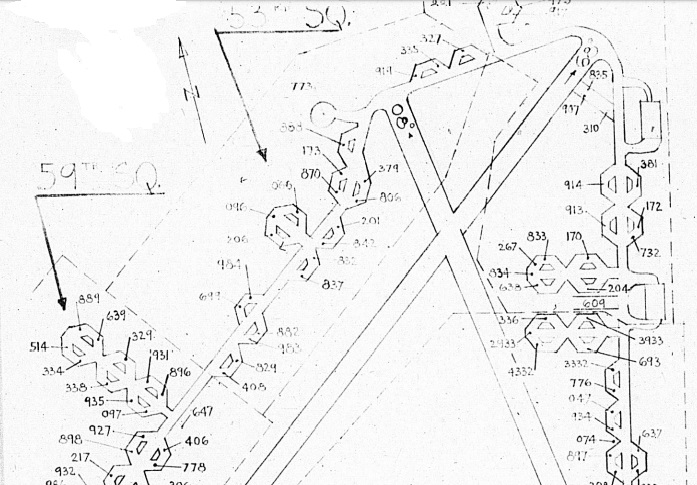
A final briefing was held by Colonel Willis Mitchell on June 2nd and, from then onwards, all crew were restricted to the base. Para racks were installed in all aircraft on June 2nd and, the following day, black and white invasion stripes were painted on the C-47s in an attempt to circumvent the friendly fire incidents experienced in Sicily.
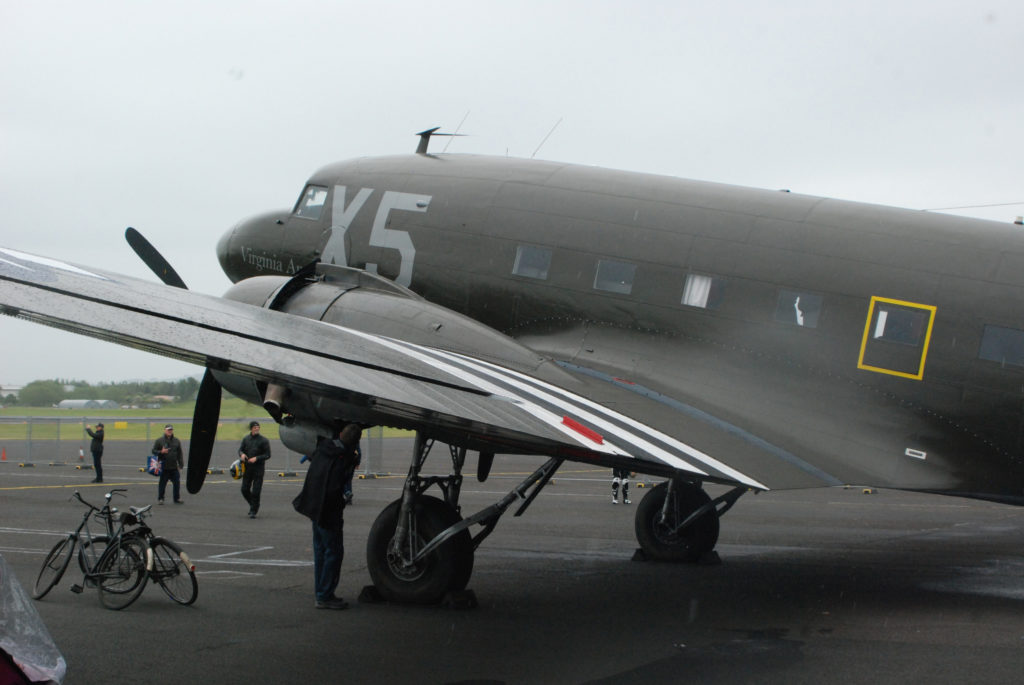
On June 6th, Barkston Heath provided two serials, 24 and 25, each with 36 C-47s/ C-53s. the 72 aircraft were part of 369 assigned to mission ‘Boston’ and carried elements of 2nd and 3rd Battalions, 507th Parachute Infantry Regiment, 82nd Airborne. As Barkston Heath’s runway was only 150 feet wide, the C-47s were parked in 3-ship Vee patterns with the initial 36 on concrete and the second 36 on grass. A final flight briefing was held by Colonel Mitchell at 22:00 on June 5th before the crews joined their aircraft. Each serial took to the air in a barely-believable 2 and a half minutes, almost a minute faster than the previous best effort. Airborne at 23:51, Serial 24 was followed by Serial 25 at 23:57. Climbing to 1500 feet, the 72 aircraft passed back over the airfield fifteen minutes later, heading south-west, en route to Normandy.
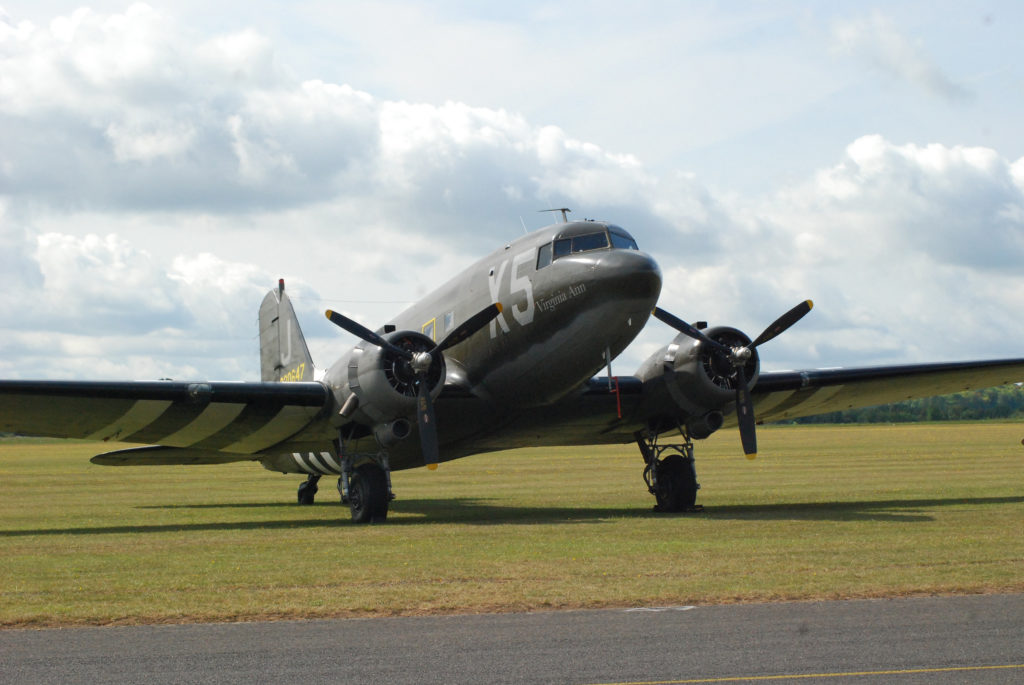
Virginia Ann, sporting 59th TCS’s ‘X5′ code, had been selected by Colonel Willis Mitchell as the lead aircraft for 61st TCG in Serial 24. This meant that, in addition to Colonel Mitchell, co-pilot Smith, Crew Chief Smith and Radio Operator Rosenthal, the crew included the 61st’s Lead Navigator, Captain Richard E. Scharf (5). From their Lincolnshire base, Serial 24 made its way south, crossing the English coast at Portland Bill at 500’, heading south-west under the level of the German ‘Freya’ radar. In the early-hours darkness, navigation lights and internal lights were turned off leaving only formation and recognition lights illuminated. To the north of Guernsey, around 50 miles from Portland Bill, a vessel code-named ‘Hoboken’ was fitted with a Eureka beacon. Upon reaching Hoboken, the armada of Dakotas turned to port onto a south-easterly course to pass the German-occupied Channel Islands of Alderney and Guernsey. Heading for the Cotenin Peninsula of Normandy, Virginia Ann was due to cross the French coast at Flamenville – a point code-named Peoria- at a height of 1500′ en route to drop zone ‘T’ to the west of St Mere Eglise. The scheduled arrival times for the two serials over ‘T’ were 02:32 and 02:38 for 24 and 25 respectively. Clear skies above the English Channel gave way to early morning banks of fog over the coast. This would present serious problems for the C-47 crews. Additionally, the Pathfinders allocated to Drop Zone ‘T’ had landed successfully and been able to initiate their Eureka beacon but, owing to nearby enemy troops, had been unable to turn on the ‘T’ of red marker lights.
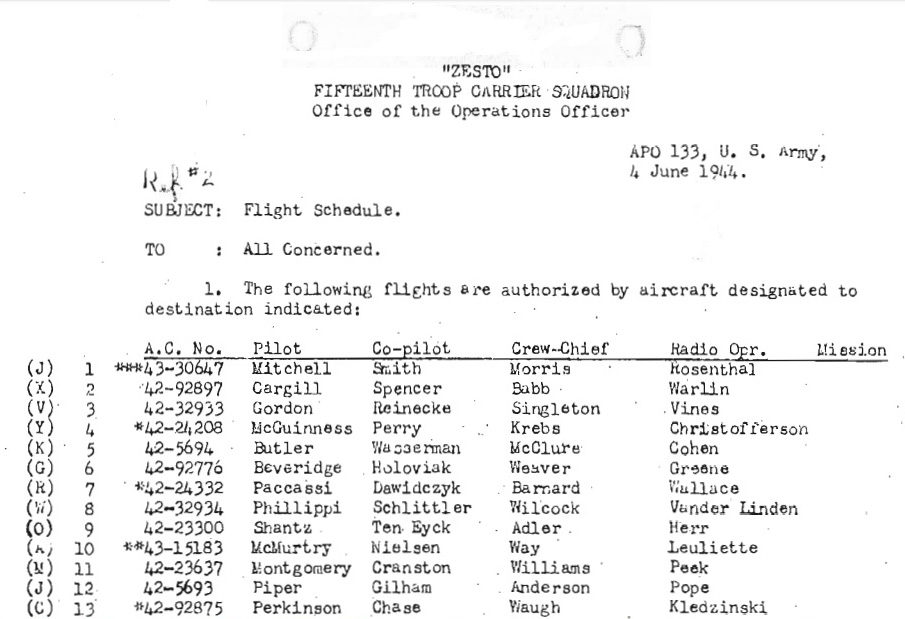
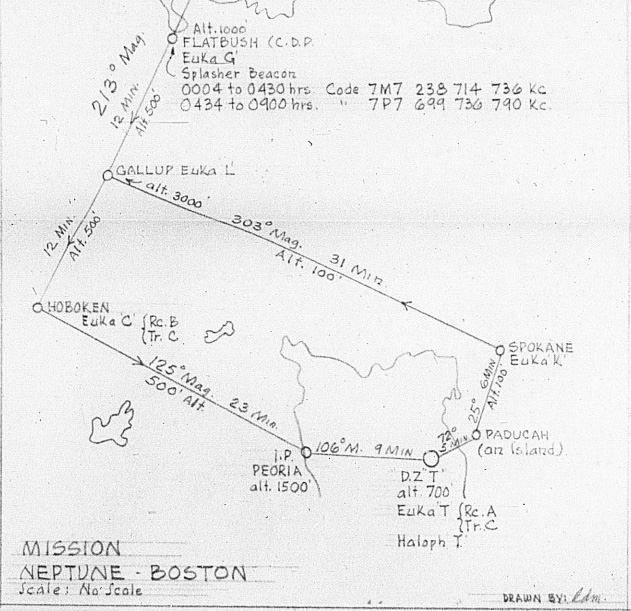
The drop order placed 61st TCG second from last after the 316th TCG (from Cottesmore), 315th TCG (Spanhoe), 314th TCG (Saltby), 313rd TCG (Folkingham) and just ahead of Balderton’s 442nd TCG (6). The German forces were well-aware of the operation by the time 61st arrived over the drop zone and they came under a heavy barrage of ground fire. The paratroops were successfully dispatched, although not as close to the drop zone as intended. Many of the 507th Parachute Infantry Regiment troops landed between the planned location and St. Mere Eglise. This was a swampy area with surface water and not ideal for the touch-down of heavily-laden paratroops. This probably accounted for some initial deaths and, of Virginia Ann’s complement of 14, two were reported as ‘killed in action’ (7). Colonel Mitchell brought his serial in below the fog bank at an altitude of 550′, below the intended 700′ but at a low speed of around 95 knots and without disruptive evasive action. The 2nd Battalion, 507th PIR reported a good jump and landing although they had problems with surface water, poor identification lights and damage to their radio equipment (8). Departing the drop zone, Colonel Mitchell dived the aircraft to a lower level to evade gunfire, but Virginia Ann was hit several times. Flak damaged the cockpit area and a bullet passed through the undercarriage area hitting Colonel Mitchell in the hand. The wound produced a lot of blood and severed two tendons, but he was able to keep flying until clear of enemy fire. Control was then passed to co-pilot 1st Lt. Bailey Smith who flew the C-47 on its homeward leg to Barkston Heath.
The first of the 61st TCG aircraft arrived back at base between 04:15 and 04:30 and, by the same time, St. Mere Eglise was safely in allied hands. The 61st TCG had lost only one aircraft, Lt William Hitztaler’s 42-23638 (9), while eight 59th TCS C-47s had been damaged and three were non-flyable. The latter three, which may have included Virginia Ann, were passed to 302 Service Squadron for repair.
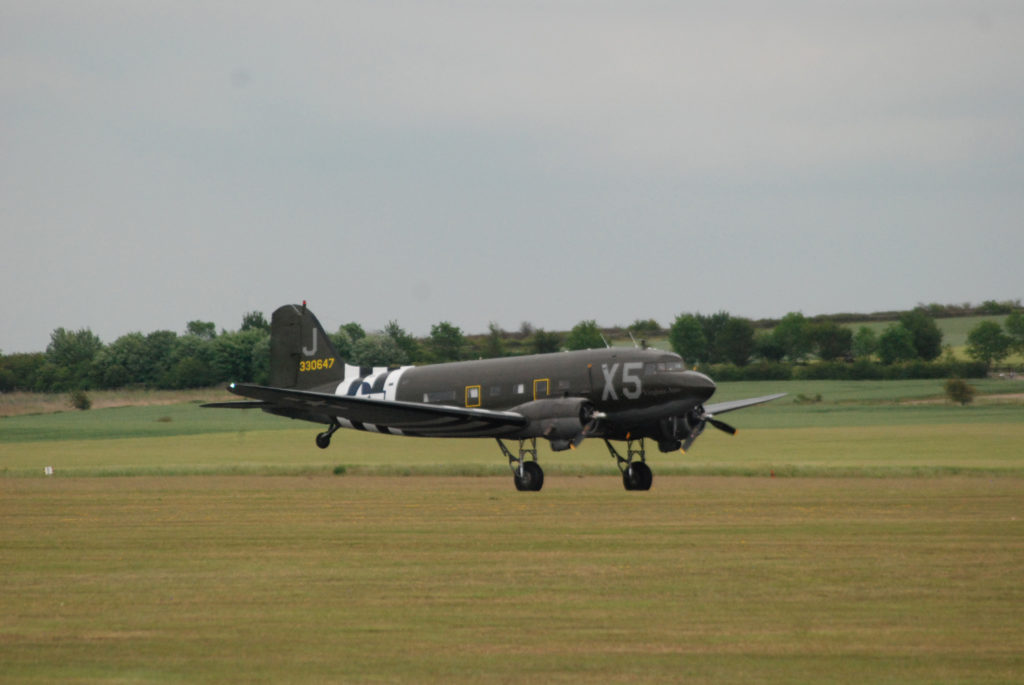
Debriefing of the returning crews was completed by 08:50 and new briefings were prepared for the following day’s re-supply operation to Drop Zone ‘N’, Mission Freeport. The 61st TCG, led by Colonel Stanley Hoyt, despatched fifty-two aircraft on Freeport, 14 each from 53rd and 15th TC squadrons and 12 each from 59th and 14th TC squadrons. Weather conditions remained quite poor and not all of the re-supply aircraft made it to the target drop points. Fierce fighting was going on beneath the aerial armada and intense ground fire was experienced from houses, vehicles and even haystacks.
Two of the C-47s damaged on June 6th, 43-15226 and 43-15312, were returned to service on 8th June but, operationally, life was quiet for 61st TCG. Rumours suggested glider operations and a second line invasion in France and, by 13th June, British Airborne personnel were bivouacked at Barkston Heath. This project never took place and, by June 20th C-47s were being adapted to offer more effective evacuation facilities. On June 21st/ 22nd a 40-aircraft operation was flown by 61st TCG to the newly-opened Advanced Landing Ground B6 near Colombs to the east of Bayeux (10). Around 900 wounded were evacuated in C-47s equipped for up to 24 stretchers. The following day, five 61st TCG aircraft flew on a re-supply mission to E1 (probably Emergency Landing Strip Poupeville) and ten to ALG A-6, Beuzeville. Virginia Ann would not have taken part in these as she was receiving a 50-hour service back at Barkston Heath.
On July 3rd, Virginia Ann’s regular pilot, Robert H.Shoemaker (Virginia Ann was Mrs Shoemaker) was promoted from 2nd to 1st Lieutenant with 59th TCS. Re-supply and evacuation missions continued with aircraft of 61st TCG often delivering wounded US servicemen to Prestwick ready for travel home to the USA in C-54s. Sometimes the number of patients delivered to Prestwick by the C-47s exceeded the number of available places in ambulances and the wounded had to wait on stretchers in the C-47s.
The 61st TCG had practised the double tow of Waco CG-4A gliders since early days in Sicily and demonstrated the art on July 10th. Exercises with British paratroops followed on 12th and three more exercises followed on July 16th with 1st Polish Brigade practising glider operations at Wittering. By the last week in July, the group was expecting the replacement of their CG-4A gliders by the heavier British Airspeed Horsa. Crew Chiefs were less than enthusiastic as they believed that the heavier gliders would put a greater strain on the C-47 engines.
Re-supply missions also stepped-up a notch with deliveries to newly-opened Advanced Landing Grounds in Normandy. The wet and cloudy month ended in tragedy for 59th TCS when two of their aircraft became disorientated while descending through cloud just to the west of Sleaford. Buckeye Belle, 42-22334, and Snatchhound, 43-15097, collided and the nine personnel on the two aircraft were all killed. This was 59th’s first accident of this nature and a majority of personnel attended the service and burial at the American Cemetery in Cambridge on August 1st 1944. the service was part of a joint burial for 100 American airmen, mostly 9th Air Force bomber crew.
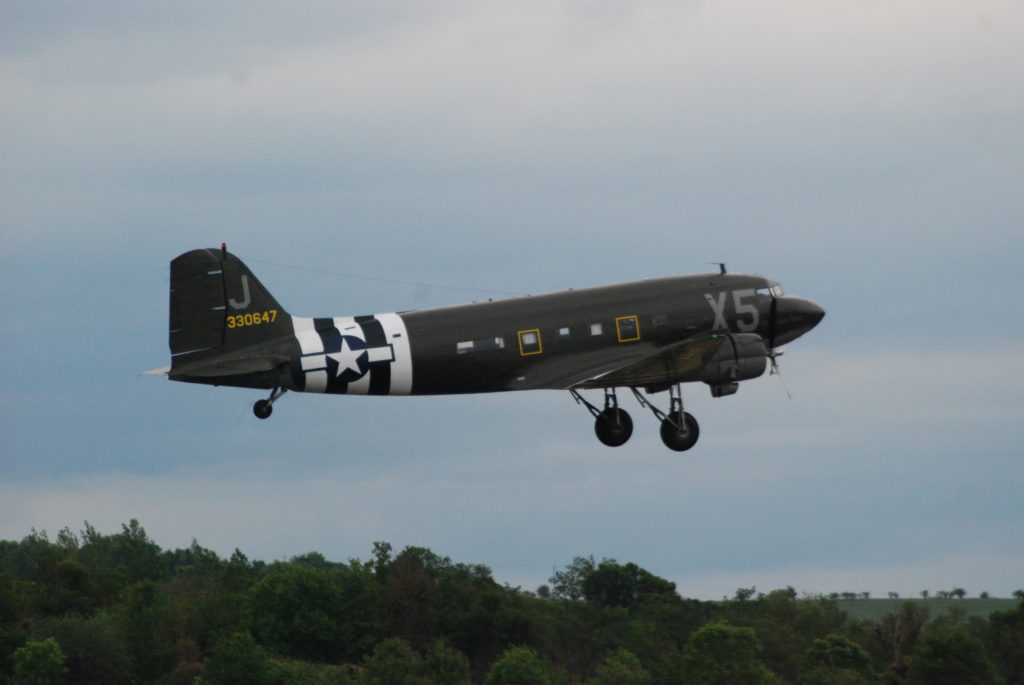
August saw the planning for future missions in Europe ramped-up with the formation of the First Allied Airborne Army headed by US Generals Lewis Brereton and Matthew Ridgeway and British General Frederick ‘Boy’ Browning. Formation and glider-towing exercises with the British and American paratroops prepared for the planned invasion of Holland. Most of the flying was by daylight and training was interspersed with logistics and evacuation missions to french landing strips such as the infamous ‘floating runway’ of Colleville-sur-Mer (A22) and Binneville (A24). the creation of the Allied Airborne force put an end to 61st TCG’s long-held hopes of returning to the USA before the end of 1944. There was still a long way to go!
By August 11th, training was proceeding with serials of 36 aircraft practising fast landing and disembarkation of troops, jeeps and hardware at neighbouring Saltby air base, home of 314th TCG. Within a few days, the time between the landing of the first aircraft, the offloading and the take-off of the last of the 36 aircraft had been reduced to sixteen minutes.
Plans were evolving quickly for the airborne forces. The ‘Anvil’ invasion of southern France in mid-August drew-in two Troop Carrier Wings but 52nd TCW remained in Britain. On August 16th, 61st TCG was put on a 4-hour alert for a full airborne drop British, Polish and 82nd Airborne troops to the west of Paris – incredibly short notice compared with the months of planning for ‘Overlord’. The ‘Transfigure’ mission was postponed a day and then called-off as General George Patton’s troops surged past the intended drop zone into the western suburbs of Paris.
A rainy weekend blended into a wet and dismal Monday August 21st with very little flying. Virginia Ann was moved into the hanger for her 100-hour inspection, just on two months after her 50-hour check-up. The Barkston Heath glider pilots were dispatched to Greenham Common during late August for 10 days work assembling part of a 1700-strong glider fleet. Virginia Ann’s 100-hour was completed on August 24th.
Full-scale exercises returned in late August with ‘Bumble Bee II’, a full night-time take-off and trial drop on a location close to Market Harborough. This operation, on August 28th, was in preparation for ‘Operation Linnet’, the planned invasion of Holland. The 52nd TCW was to deliver paratroops from the British First Airborne Division, the 1st Polish Parachute Brigade and the US 82nd Airborne on the first day of the invasion. Follow-up flights on D+2 were to deliver troops and vehicles to airstrips captured by the Allies. These operations would capitalise on the exercises 61st TCG had been carrying-out for several months.
On September 1st, para-racks and British airborne accessories were installed on 19 of the 59th TCS C-47s (the squadron roster having expanded from the original 9 aircraft towards the ultimate number of 22). Although wet weather prevailed, all 61st TCG aircraft were marshalled into position at Barkston Heath by 19:00 on September 2nd and remained in place throughout the 3rd. On 4th September, it was rumoured that the allied ground forces had already reached the ‘Linnet’ drop zones. The mission was duly cancelled and the paratroop accessories removed prior to the C-47s reverting to logistical operations in support of General Patton. The 3rd Army was running low on fuel and ammunition owing to the fast advance through France. Freight and evacuation operations were interleaved with periods of standby for planned airborne paratroop operations. the next of these was ‘Comet’, the immediate precursor to ‘Market Garden’.
‘Comet’ plans had the 61st TCG due to operate four serials from Barkston Heath to Drop Zone ‘X’, WNW of Arnhem. The plan differed from ‘Linnet’ in that British and Polish troops were to be dropped but not 82nd Airborne or air-portable vehicles. Chipping Ongar was to be used as a take-off airfield for any glider-towing operations and, to this end, an advanced echelon of 61st glider personnel was dispatched to the Essex airfield on September 7th. That same afternoon, all Barkston Heath aircraft were marshalled ready for an early morning take-off on ‘Operation Comet’. Poor weather intervened on September 8th and the operation was postponed 24 hours although the aircraft remained marshalled. On 9th September an improvement in the weather led to the Barkston Heath aircraft being marshalled nose-to-tail ready for take-off. There was, however, concern that the allied forces were not advancing swiftly enough to achieve the ‘Comet’ objectives and, on the evening of 10th, the mission was cancelled. Indeed, Comet, with its comparatively small airborne force would probably have been a disaster and its evolution into ‘Market Garden’ meant that at least some of the objectives were met. Essentially, the ‘Market’ part of the operation was the same as ‘Comet’ but with the addition of two American airborne divisions. The ‘Garden’ element was where allied ground forces launched a swift advance through enemy-held territory to join-up with the airborne forces already on the ground in advanced positions. Word was conveyed to 61st TCG on September 11th that the new mission would be a synthesis of the last three plans incorporating a daylight parachute drop, glider landings and, subsequently, a landing of troops at an advanced landing ground.
While ‘Market Garden’ was being planned, the 61st went back to hauling supplies to Patton’s 3rd Army. On September 11th 1944, 30 C-47s from 61st positioned from Barkston Heath to Membury and, from there, hauled fuel to the advanced landing grounds A82 at Verdun/ Etain, A63 at Villeneuve/ Vertus in Champagne country just south of Epernay and to A62 at Rheims. A total of 11,350 US gallons of fuel were delivered during the day. By September 13th, additional missions had been added to re-supply British forces via the airfield B56 at Brussels.The 59th experienced anti-aircraft fire as they passed over Boulogne which reinforced the message that the Allies didn’t control the channel ports essential for logistics. Flights to Brussels proved popular and, when overnight stops were necessary, returning crews reported that the quality of the beer and the local girls was favourable. On September 14th, 59th aircraft delivered armaments to B56 (Brussels), B60 (Grimbergen, Belgium) and B35 (Godelemesnil, near LeTreport, France). On the return leg the following day, injured British soldiers were flown back to Broadwell and passengers delivered to Northolt.
On September 16th, some 61st TCG C-47s delivered glider personnel to Chipping Ongar while, from 10:00, the aircraft at Barkston Heath were fitted with para-racks again. Each squadron marshalled 18 aircraft into combat take-off positions and every C-47 was marked with the relevant ‘Chalk’ markings in preparation for a drop of British troops the following day. Given past cancellations, expectations for the operation weren’t high but, as 17th dawned as a calm and slightly misty autumn Sunday, the go-ahead for ‘Market Garden’ was given.
The first serial of 61st TCG aircraft departed Barkston Heath around 15 minutes before midday with Colonel Willis Mitchell once again at the head of the lead squadron, this time the 17 aircraft of 14th Troop Carrier Squadron. Flying with two other IX TC Command wings, 50th and 53rd TC Wings, this was the first time 52nd TCW had flown an operation 100% in daylight. The basic reason behind this was that mid September featured very low moonlight and it was deemed dangerous for paratroops to jump with no light at all. The Dark Moon wasn’t the only issue: poor visibility at D-Day had been a problem and autumn mists would have been likely during early mornings in Holland. The American aircraft carried British, US and Polish paratroops while the two participating RAF Groups (38 and 46) were dedicated to glider-towing operations. As well as 14th TCS, 61st TCG also included 17 C-47s of 53rd TCS and 18 aircraft each from 15th and 59th Troop Carrier Squadrons.
In total, 423 52nd TCW aircraft headed for the Netherlands carrying a total of 6531 troops and two war correspondents. The 61st TCG was the second American formation to drop paratroops and followed the 314th TCG led by Lt. Colonel Arthur Tappen. The two serials of 36 aircraft provided by 314th were due to start dropping the British 2nd Battalion at 13:40 but were around 10 minutes late. This may have been owing to early morning fog which had demanded that the squadrons flew further south than planned before joining formation. 61st TCG made up some of the lost time and approached Drop Zone ‘X’ around 6 minutes behind schedule. Their aircraft contained British 1st Battalion, the 1st Parachute Brigade Headquarters team, a reconnaissance squadron, elements of 16 Field Ambulance and the advance party of 4th Parachute Brigade. Although 15th TCS reported dangerously accurate flak along the route, the actual drop met with no opposition and all 61st’s troops were on the ground by 14:08. The group had crossed the Rhine and headed north-east over the town of Rinkum before turning to follow the line of Telefoonweg to the drop zone which was just before the Utrecht to Arnhem railway line. Approaching the drop zone at a slow speed of 85 to 90 knots in a shallow dive, the first jumpers left the aircraft at around 600′ while the last of the fifteen British paras (11) would be out of the door at 500′, an altitude which gave a time of only 15 seconds in the air. The shallow dive was intended to ensure that parachutists didn’t collide with the aircraft’s tailplane. One parachutist died in the jump, ten of 15th’s 110 supply bundles failed to release and one aircraft sustained wingtip damage but, otherwise, the 61st had an excellent mission and were circling ready to land at Barkston Heath around 16:30. The ground forces had enjoyed a good landing and had met little resistance during the 90 minutes of the airborne assault. Their good fortune would not last.
Four of 52nd TCW’s aircraft failed to return but none of these were Barkston Heath aircraft. Virginia Ann’s squadron, 59th TCS, had fielded 18 aircraft, none of which appeared to be 43-30647 although it is possible she was flying with either 14th or 53rd TCS.
Market Garden was an unusual operation in that it was split into two mutually-dependent daytime operations with airborne operations carried-out over two successive days. Market 1 on September 16th was followed by Market 2 the next day, this time with 61st TCG towing Waco CG-4A gliders loaded with 82nd Airborne troops bound for Nijmegen. The two-day aspect of the operation was due to a shortage of aircraft to carry the massive armada and false confidence that good weather would prevail for at least four days. The day-time operations meant that German gunners had clear targets and the two-day schedule gave them ample warning of what to expect on day two. Many of the formations of C-47s and C-53s ran into heavy flak although the 61st was fortunate to lose only two of the eighty aircraft dispatched from Barkston Heath on the late morning of 18th September. 15th TCS and 53rd TCS were in serial A-40 and each squadron provided 20 C-47s and 20 CG-4A gliders. The gliders of 53rd transported 108 men, 17 jeeps and one 75mm gun plus stores and ammunition. Lifting from Barkston Heath at 11:00, they passed back over the airfield in formation at 12:00. After losing two aircraft on the mission, they arrived back home at 16:45 with many of the surviving crews reporting damage from bullets and shrapnel. One C-47 made a no-brakes landing while another crabbed across the airfield, eventually landing safely with a badly damaged rudder. The 15th TCS landed just before 53rd, while Serial 50, comprising 14th and 59th TC Squadrons, was back home around 17:40. 14th TCS is recorded as supplying 19 aircraft/ glider pairs although it seems likely that another squadron supplied a 20th C-47/ CG-4A combo. There were no losses amongst 14th TCS, although almost every aircraft reported some form of battle damage. 59th TCS supplied 20 C-47/ glider pairs and twenty aircraft returned home safely. Visibility had been less than perfect over the landing zone but the gliders were released safely. Immediately after the return to Barkston Heath, 59th dispatched 18 Dakotas to Aldermaston ready for a re-supply flight the following day. Virginia Ann is not mentioned as flying on either of the 18th September missions but it seems likely she participated in one or both. During Market Garden II, 52nd Troop carrier Wing delivered 3035 troops, 99 jeeps with 11 trailers, 21 pieces of artillery and large quantities of supplies and ammunition to the 82nd Airborne commanded by 61st’s old compatriot and one of the US Army’s greatest leaders, General James Gavin. Their arrival could not have been more timely: the 82nd were desperately trying to hold the landing zone for the gliders which were carrying essential anti-tank artillery, medical and signals personnel and reinforcements. It was a close thing, with 1st battalion of 508th PIR storming across the Landing Zone just as the gliders arrived, chasing German troops from their 20mm artillery. Behind them the gliders were landing and disgorging troops, who were immediately engaged in combat. The hot welcome for the new arrivals continued as 135 8th Air Force B-24s roared across the landing zone at low level, each dropping 20 bundles of supplies. The reinforcements eventually helped the 82nd capture the critical Nijmegen Bridge in a savage hand-to-hand battle on September 20th, just as the British armoured column arrived.
On Tuesday 19th September, 14th and 15th TCS were due to fly 40 C-47/ glider combinations between them from Barkston Heath to Holland. The first few aircraft did take off, but were recalled when the mission was postponed due to weather. The 52nd TCW were due to send 178 aircraft/ glider pairs plus 108 aircraft carrying paratroops and 72 re-supply aircraft. Only the re-supply element took-off, with 53rd and 59th TCS departing Aldermaston around 12:55 on Serial A94, Market III. 53rd sent 15 of their own C-47s plus two from other squadrons while 59th sent a further 18 C-47s. The drops were made successfully at 15:30 at a point 6 miles SSW of Nijmegen and both squadrons were back home at Barkston Heath by 18:00. Three aircraft reported battle damage. The curtailed operations meant that the planned drop of the entire Polish Independent Parachute Brigade was postponed along with the transport of an American engineering battalion due to construct an airstrip at Arnhem. Parts of the Polish glider lift did go ahead from southern England, but their landings were compromised by the German counter-offensive. September 19th was the day the Axis forces began to gain the upper hand.
Poor weather from September 20th to 22nd precluded further operations by the 61st TCG but better conditions on 23rd led to Market IV. 14th and 15th Troop Carrier Squadrons each supplied 20 aircraft to tow 20 gliders on Serial A89. One aircraft had to abandon its mission, but the rest arrived over the Landing Zone around 16:05 and released their gliders. Despite anti-aircraft fire, most gliders were seen to land successfully and the C-47s were back at Barkston Heath by 18:30. The weather was poor the following day and, on September 25th, forty aircraft from the 53rd and 59th TCS were positioned to Chipping Ongar ready for improved conditions. However, the weather remained poor on 26th.
RAF supply drops had continued every day from 20th to 25th with increasing losses of Short Stirlings and Dakotas and decreasing results as the Wehrmacht over-ran British positions at Arnhem. Over the 9 days, the 52nd TCW diaries voice concern for the British 1st Airborne Division they had delivered on Market I and, by 26th, it was realised that the Battle for Arnhem was lost. General Roy Urquhart, Commander of 1st Airborne, later wrote to IX TCC to thank them as ‘In the first place you gave us an excellent start. The result of the parachute drops was quite first class and exceeded in success and accuracy anything achieved either in operations or in exercises….Then we must thank you also for the efforts made to reinforce us during our nine days battle on the ground’.
61st TCG switched immediate attentions to supply missions; 20,000 lbs of fuel were delivered to Brussels (B58) airfield on 29th September by 61st. Twenty-one 61st TCG C-47s delivered 105 lbs of fuel to B56 (Evere) on 30th and 14th TCS reported logistics operations to B59 (Ypres), Evere and B84 (Rips). Missions continued into October with many of the freight operations taking place between Kemble in Gloucestershire and Belgium. By late October/ November freight flights were continuing coupled with evacuation of wounded personnel. A63 (Villeneuve/ Vertus), A83 (Denain/ Valenciennes) and the newly-opened A88 (Maubeuge) were all visited frequently along with the two British bases at Brussels, Melsbroek and Evere. Large shipments of Pierced Steel Planking were ferried to Lille (B51) for the construction of new fighter strips for the advancing allies. When weather permitted, some glider training took place with single and dual tows from Barkston Heath. The drab winter weather led to 61st TCG operating weather flights between British and Continental airstrips in a specially- equipped C-47 in order to assess the viability of formation flights.
By December 1944, the 61st were convinced they were due to move from Lincolnshire to Boreham, next to Chipping Ongar in Essex. However, when Virginia Ann’s pilot, Robert H.Shoemaker, returned from UK-leave on December 20th, it was still to Barkston Heath. A permanent move to Essex never did take place. The fuel flights continued, often up to sixty aircraft each day – indeed, the volume was such that 61st was allocated a couple of B-24s which were scheduled to be converted to C-109 flying tankers. Barkston Heath experienced cold, snowy, foggy weather during the second half of December. This precluded flying over much of western Europe – a situation which prompted the German counter-offensive through the Ardennes. The ‘Battle of the Bulge’ began on December 16th and weather conditions only improved sufficiently for support flights on Christmas Eve. The 61st commenced support flights from Southern England, with 14th TCS dispatching 20 C-47s to A70 (Laon/ Couvron) on 24th December. On the same day, 15th TCS sent 20 aircraft to Lessay (A20) and Prosnes (A79) which, like A70, were on the southern borders of the Ardennes. Aircraft of 53rd TCS and 59th TCS were loaded at bases in Southern England ready for Christmas Day operations. The 61st were to spend the remainder of the year delivering troops and armaments to ‘rail head fields’ close to the fighting at Bastogne. A new arrangement of stretchers in the C-47s enabled each aircraft to return with 24 wounded rather than 18. Virginia Ann’s group was therefore involved in support missions during the Battle of the Bulge rather than actual supply or troop drops.
January 1945 was a snowy month for 61st TCG with snow lying for fifteen of the thirty one days. The runway was cleared to encourage operations and glider landings were practised in the snow with CG-4As. Cold weather on the continent saw delivery flights carrying snow shoes to A93 (Sedan, on the edge of the Ardennes) for US troops still recovering from the Battle of the Bulge. 61st’s complement of aircraft at the start of 1945 was: 10 C-47s, 72 C-47As, 5 C-47Bs and 86 CG-4A gliders.
February 1945 proceded with all but 3 days spent on freight and evacuation flights to advanced landing grounds such as A41 (Dreux), A42 (Villacoublay), A93 (Liege), Y33 (Thionville), A50 (Orleans), A79 (Prosnes), A54 (Laval), Y9 (Dijon), A46 (Toussus le Noble), A70 (Couvron), A60 (Beaumont sur Oise), A62 (Reims), A68 (Juvincourt), A47 (Orly) and A56 (Le Hamill) as well as British fields B77 (Gilze/ Rijen) and B75 (Nivelles). The latter flights were via the RAF Dakota airfields of Broadwell and Blakehill Farm in Oxfordshire. By February 12th, Virginia Ann had accumulated 700 hours total time on her engines and needed a new set of Twin Wasps. As well as freight missions, 61st also flew two glider operations, Able #1 and #2, from Cottesmore on 19th and 20th February. The move away from Barkston Heath was getting closer, with Abbeville, close to the Channel coast, the dedicated field. Abbeville had been used by the British Expeditionary Force prior to Dunkirk and had, subsequently, become an important ME109 base for the Luftwaffe. In September 1944, retreating German forces had dynamited many of the airfield’s facilities and mined the runways prior to its liberation by Polish troops. Even by the following February, it was found to be still unusable when two 61st TCG flights on 25th February had to divert to alternative strips at Amiens and Achiet. While the move to Abbeville would bring 61st closer to the front line, Barkston Heath was also becoming more dangerous when, on the night of March 4th, it experienced its first serious enemy air raid. There were no injuries but three C-47s were damaged.
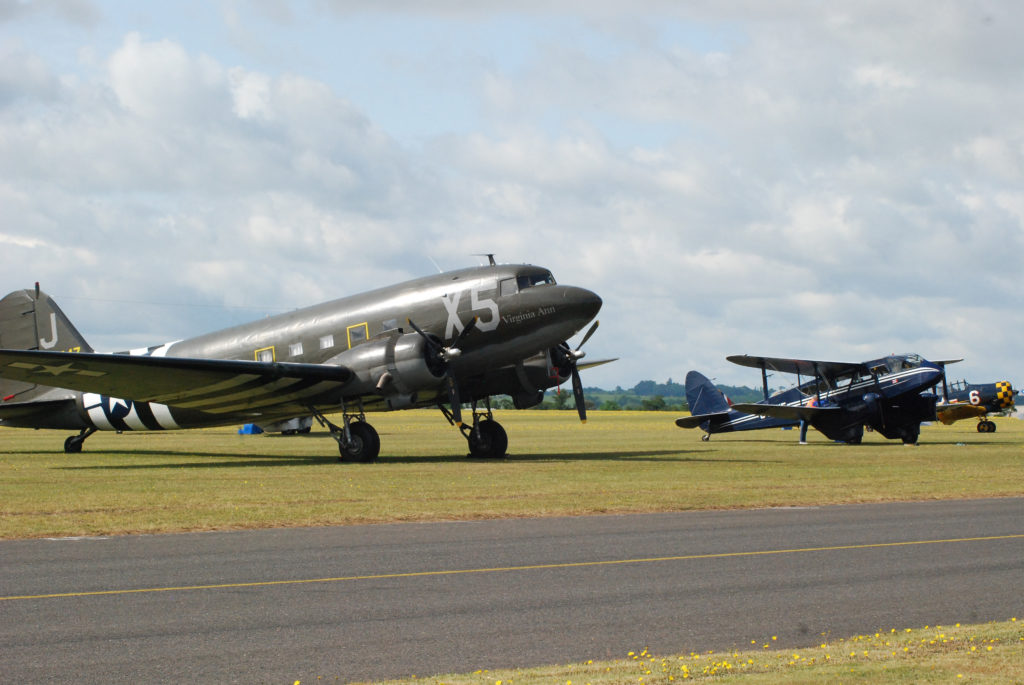
Flights started moving sections of 61st TCG from Lincolnshire to France as from March 7th 1945 with the main move taking place on 13th March. A small training mission, suitably names ‘Token’, was carried-out on 24th when Colonel Mitchell led two serials of three aircraft loaded with paratroops from Chipping Ongar to Abbeville. Since 19th March, the Rhine Crossing mission ‘Varsity’ had been under discussion at 61st and it was soon discovered that all aircraft would operate from Chipping Ongar and would carry British 6th Airborne troops to Wesel before returning to Abbeville. By March 21st, the Group’s air echelon had returned to Chipping Ongar and the four Troop Carrier Squadrons were preparing 21 aircraft each.
Varsity was to be the airborne element of the Rhine Crossing and would be the 61st fifth major ‘D-Day’ operation. The ground operation, named ‘Plunder’ commenced at 21:00 on March 23rd with American, British and Canadian troops due to cross the Rhine near Wesel. Unusually, the airborne element would be landed after the ground offensive on the morning of 24th. The glider and paratroop landings would be in daylight and close to the ground forces to avoid the problems experienced at Arnhem. The British 6th Airborne carried by 61st TCG were tasked with taking the villages at Schnappenberg and Hamminkelm, three bridges across the Ijssel and the high ground at Diersfordter Wald. The operation would be the largest single drop in history and involved 541 troop carriers plus a further 1050 troop transports towing 1350 gliders (12).
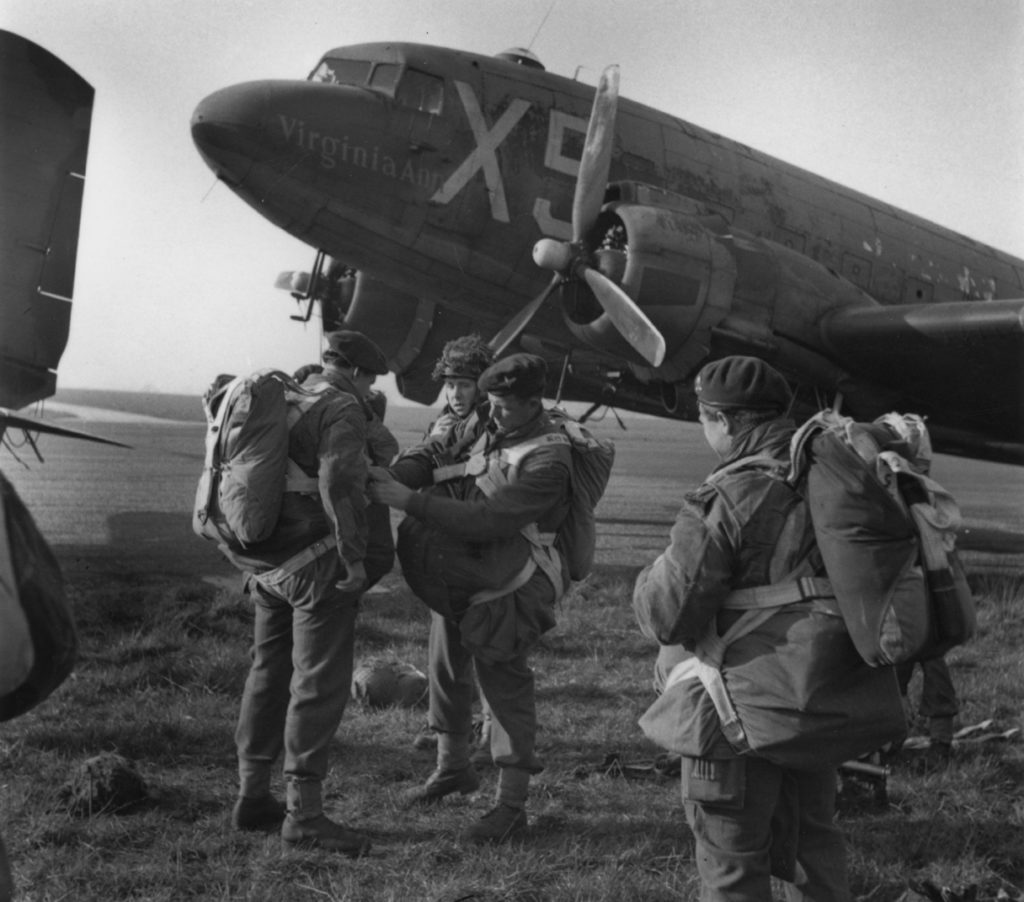
On the morning of March 24th, 61st TCG was to furnish 80 C-47s with one operationally ready as a spare. 53rd TCS’s 20 C-47s began take-off at 07:15 followed, at 07:20, by 20 aircraft of Virginia Ann’s squadron, 59th TCS. The 59th were carrying 327 troops of the British 6th Airborne, 14th TCS transported Canadian paratroops in fourteen aircraft and 15th TCS supplied a further twenty C-47s. The 61st TCG, led again by Colonel Willis Mitchell, was also the leading group of 52nd TCW with 45 C-47s in Serial B1 and 35 in Serial B2 all bound for Drop Zone A. Just as Colonel Willis was about to commence his take-off run, a V-1 flying bomb appeared over Chipping Ongar airfield at an altitude of around 300′, hotly pursued by a Spitfire. Both passed safely clear of the marshalled aircraft (13). The rest of the mission proceeded in an orderly fashion with Serial B1 over the drop zone at 10:00 and B2 four minutes later. All but one of the 61st aircraft made it safely back to land at B-92, Abbeville, around 11:30. The aircraft lost was flown by Major Thomas Cargill of 14th TCS.
The success of the Rhine Crossing meant that 61st TCG was again heavily involved in freighting fuel and supplies to forward landing ground while repatriating casualties. On March 31st 1945, 14th TCS, 15th TCS and Virginia Ann’s 59th TCS each supplied 15 aircraft for a re-supply mission to the Advanced Landing ground Y-74 at Eschburn, near Frankfurt. this was to be 61st TCG’s first landing on German soil and the aircraft taxied past hangars and ground installations still burning from the enemy withdrawal. As the group moved into April 1945, they had use of 14 C-47s, 66 C-47As, and 6 C-47Bs. The operations moved steadily to new landing grounds such as Ettingshausen, Bracht, Paderborn and Wenigenlupnitz. French prisoners-of-war were transported back to Abbeville, often after 5-6 years in German captivity. The former Junkers airfield at Merseberg yielded various strange aircraft and two ME163 Komet jet fighters. The latter were dismantled and transported to Bovingdon, England, by 61st TCG Dakotas.
Colonel Willis Mitchell departed for the USA by sea from the Clyde and a new CO joined 61st TCG. Briefly, aircraft from the four squadrons returned to Barkston Heath for a training jump with British 1st Airborne at the end of April. The exercise was cancelled and the Group were all back in Abbeville by May 3rd as news of an imminent German surrender circulated. The Armistice was signed on May 7th and, within two days, the 61st was in the process of being reassigned from US Strategic Forces Europe to Air Transport Command with plans to form a European Air Transport Service. Some aircraft remained in Europe with the ATC, others departed on another transatlantic crossing to Waller Field, Trinidad. The 53rd sent sixteen C-47s westward to the Caribbean with the first seven arriving in Trinidad on 19th May and the balance in place over the next couple of days. Waller Field had been established to counter the threat of Vichy France in the Caribbean and proved to be a valuable stepping stone on the southern Atlantic Crossing route. However, 61st TCG was not to remain there long; officially taking-up residence on May 29th, the group was deactivated on 31st July 1945. Virginia Ann is recorded (2) as being back in the USA on 11th August and at the Walnut Ridge airfield of the Reconstruction Finance Corporation in Arkansas by 21st October. Many of the RFC’s 10,000 plus ‘guests’ never left the airfield again, being turned into aluminium ingots at two smelting plants. However, C-47s were in demand in the civilian market and were too valuable to turn into cheap aluminium cladding for America’s post war building boom. Virginia Ann was soon on her way to a new chapter in her life in the civilian world.

Virginia Ann’s history is a little sparse in the 1940s but sources (2) have her moving to the Dallas Aviation School as NC62570 and, subsequently, to the National Skyway Freight Corporation in 1947. Major William Long owned both the Dallas Aviation School and Pioneer Air Lines which flew services throughout Texas. It is possible that NC62570 flew for the airline side of the operation. National Skyway Freight was the forerunner of the Flying Tiger Line and was established by former Tiger veterans with a plan to use 12 redundant Budd RB-1 Conestoga transports bought at a knock-down price from the US War Assets Administration. The stainless steel RB-1 was, predictably, heavy and under-powered and the company quickly switched to a fleet of 16 C-47s on their path to becoming America’s first all-cargo airline. These war surplus aircraft started arriving at the NSFC’s Long Beach base in Spring 1946 and, by the end of the year, the fleet was operating over 1 million ton/ miles/ month (14). Virginia Ann was delivered in 1947 and the last batch of military C-47s, often painted with the Tiger’s famous ‘Shark Teeth’, arrived by March of that year. The company changed its name to the Flying Tiger Line in February 1947 and C-54s were commissioned later in the year to accommodate both transcontinental and trans-pacific freight services. Throughout the late forties and early fifties, Flying Tiger C-47s contributed to freight services and passenger charters around the USA but, by the start of the new decade, they had been replaced by a fleet of C-46s.
At some stage in the 1950s, it seems likely that Virginia Ann was sold to Thompson Products Inc of Cleveland, Ohio. A Certificate of Airworthiness was issued for NC62570 on 13th April 1956 and, in 1958, Thompson merged with Ramo Wooldridge to create the automotive/ aeronautical combine TRW. During their long history in aviation, Thompson had supplied parts to Lindberg’s ‘Spirit of St Louis’ and went on to contribute to the US space industry. NC62570 was probably used as a corporate aircraft and was converted to a Hiper DC-3 configuration by Pan American at Brownsville, Texas (15) on 15th February 1955. The conversion added wheel well doors, DC-4 P&W R2000 powerplants, shorter exhausts, longer propeller bosses, upgraded instrumentation and climate control. Officially registered to the TRW combine in 1963, by 11th July 1966 she had moved on to the Soundlock Corporation of Georgia.
Based at the newly-opened airport of Hazelhurst, Virginia Ann was re-registered N625SL by the company’s owner, Claude P.Cook. Soundlock appears to have been a company associated with acoustic and sound proofing equipment but Claude P.Cook had wider interests. Hazelhurst is the main town in Jeff Davis County and considered Cook to be a ‘one-man chamber of commerce’ for the area. Hazelhurst had aspirations to be the ‘industrial city of Georgia’ balancing agriculture with industry and Claude Cook’s efforts helped attract Emerson Electrics (air conditioning, fans), Otis (lifts) and Ero Industries (sleeping bags) to the town. The executive format of the DC-3’s cabin would have been an attraction for Cook’s networking activities and the aircraft frequented airports across the south-eastern USA. Pictures of N625SL taken at Jackson County, Michigan in 1967 are posted at the www.aerovisuals.ca and www.airport-data.com sites by the Chief Pilot’s son, Reid Campbell. The short video was taken in the Fall of 1966 when N625SL was still fitted with the undercarriage doors and carried nose art. Thanks to Reid Campbell for providing the film clip.
Virginia Ann’s distinctive red and black livery changed only slightly over the years and can still be seen in evidence in 2016 when she had moved to California with Barry Fait. It is hard to make out the logo on the nose, but it is possibly connected with the University of Georgia Bulldogs football team. Gerard Helmer’s excellent photo of N62CC at Key West in the 1980s certainly shows the Bulldog motif on the tail fin.
Virginia Ann’s official ownership changed to Cook & Company on 18th August 1969 and the registration was subsequently changed to N62CC as from 1973. Some sources have the registration cancelled in December 1983 and restored in July 1985 (2) but, otherwise, the aircraft seems to have stayed with Cook & Co. until sold to the Virgil Air Corporation of Bethel, Connecticut, in February 1988. the new owner was a drinks and beer distributor in Bethel who had plans to operate ‘on demand’ air transport under FAR licensing. Apparently, he had been encouraged to buy the aircraft by his brother-in-law from Maine who considered it to be a bargain (16). Although it didn’t really suit their requirements, it did make numerous flights with management/ piloting facilities provided by Capital Air of Oxford, Connecticut. Destinations included Key West (see photo above) and various New England destinations. It seems likely that Virginia Ann visited Oxford-Waterbury some 30 years before D-Day squadron!
By February 1993, N62CC had moved to Vandemeer Co. Inc. of Ridgewood, New Jersey. Several documented owners of this period may well be connected as, on 15th June 1993, the aircraft was registered to Deutsche Kraft Inc. of Lehighton, Pennsylvania, before moving back to another Ridgewood-registered company, Classic Air Transport on 30th November 1993. Deutsche Kraft also owned another classic in the early nineties, Beech 18 N38CB, which was also registered in Lehighton. Ruud Leeuw reports on his informative website (17) that N62CC moved south to Tennessee to join Catalina Air Inc. on 22/11/1994. Registered in Alcoa, the DC-3 was based at the neighbouring McGhee Tyson Airport. When Ruud Leeuw caught-up with Virginia Ann at McGhee-Tyson in early August 2001, she was still registered to Catalina but was known locally as ‘Steve Lance’s plane’. Catalina was registered to operate under the FAR135 category for on-demand charter in a 16-seat executive configuration and retained the undercarriage doors fitted in 1955.
The next owner was Air Classics LLC, recorded as being from Sheffield, Maine, and they registered Virginia Ann on 20th August 2004 and based her at Swanton Airport, Vermont. She still had very low air time and appears to have flown very little over the next few years. Indeed, new propellers were fitted in 2005 and were reported to have only a single hour’s flying time by 2010. The aircraft had been advertised for sale in 2008 for a mere $175,000. A new owner did materialise in 2010 when Kenneth Oddy of Orange Park, Florida bought Virginia Ann on June 18th and registered her on July 23rd. There is little detail of her new operations but on 22nd June (maybe July?) 2012 Barrett and Coleman Fait of Newport Beach, California bought her and registered her to their newly-formed company Mission Boston D-Day LLC. She flew to her new home in Chino, California and started putting in some hours. She attended the EAA Oshkosh Fly-In summer 2013 and is the subject of several excellent U-tube videos during 2015 and 2016 still in her red and black TRW livery. However, by the May 2017 fly-in at Flabob Airport she was resplendent in olive drab colours, D-Day invasion stripes and had regained her name, Virginia Ann, as a tribute to her past crew, pilot Robert H.Shoemaker, co-pilot Beheler, crew-chief Shurley, radio-operator Rosenthal and, of course, Virginia Ann Shoemaker herself.
References:
(1) The names of the paratroopers carried by Virginia Ann on D-Day 6th June are documented in the next section. The information was obtained from the 507th PIR Roster on site www.usairborne.be.
(2) The background chronology and history for Virginia Ann is from JMG Gradidge’s definitive work ‘The DC-3 and its predecessors’ published by Air Britain in 1984.
(3) The detail for 61st TCG operations throughout the war has been taken from the fantastic website www.ww2flyers53rdtc.com which interweaves the operational diaries compiled by each of the four 61st TCG squadrons with individual diary entries and memories. As the site disclaimer mentions, there are many discrepancies (even between the four contemporary squadron accounts) but the picture provided of day-to-day life with a WW2 Troop Carrier Group is excellent.
(4) The story of Navigator Allan Wrang and the initial flight from Morocco to Great Britain is taken from the www.ww2flyers53rdtc.com site. The author had also spoken with Allan Wrang. After the initial close escape from internment in Portugal, Navigator Wrang was returned to Morocco to assist with a further ferry flight for 52nd TCW. This time, 42-23395 of 314th TCG was due to depart Marrakech with an ultimate destination of Saltby, Lincolnshire. Carrying a full crew plus four passengers, the captain was Clarence Anderson, co-pilot Merril Smith. After 13 hours flying, the aux tanks were dry, the two P-38 drop tanks in the cabin sucking on fumes and the engines fully leaned-out. Making landfall in the neutral Republic of Ireland, 42-23395 landed at Rinneanna in County Clare (now Shannon Airport) on March 5th 1944. The aircraft and crew could theoretically have been interned by the neutral country but, after some discussion and (presumably) refuelling, the C-47 was allowed to depart for Britain later the same afternoon. This was the last allied aircraft to land at Shannon by accident during WW2.
(5) Much of the Operation Overlord information is taken from the very informative site www.6juin1944.com. Virginia Ann is actually documented as aircraft ‘J’ with 61st’s 15th TCS, perhaps because she was flown by Colonel Mitchell at the head of serial 24. The 61st TCG diaries also claim she was in 15th for D-Day while her regular pilot of later days, Robert Shoemaker, was flying 42-23329 in the following serial, 25. Virginia Ann’s 59th TCS carried the code X5 while 15th TCS carried Y9.
(6) C-47/ R4D units of the ETO and MTO by David Isby, published by Osprey, 2005.
(7) From www.usairborne.be Roster of 507th PIR.
(8) Battle reports taken from contemporary 61st TCG debriefing/ interrogation notes published on website www.6juin1944.com
(9) 1st Lt. Hitztaler parachuted to safety and was eventually able to report back to his unit on June 21st 1944. His brother, a paratroop with the airborne forces, dropped with 303rd TCS on Serial 26 and was murdered in cold blood by German troops at Hemevez on June 6th.
(10) Colonel Mitchell reported the destination as ‘B-6 to the east of St Mere Eglise’ but it may have been A-6 which was the first USAAF ALG and is at that location.
(11) Fifteen paratroops is quoted here as an average figure, some sources report up to 19.
(12) Figures for the number of aircraft involved vary. The totals quoted here are from Maurice Tugwell’s ‘Airborne to Battle’. Colonel Willis Mitchell’s estimate was for 1682 aircraft, 1600 gliders inserting the paratroops into German lines within 1 hour and 58 minutes.
(13) Strangely enough, a similar incident occurred with the 316th TCG after take-off from Wethersfield. A lone V-1 was seen chugging across the airfield below the circling troop carriers ( Col. Mitchell reports on www.ww2flyers53rdtc.com, British paratroops mention on www.erenow.net/ww/operation-varsity-british-canadian-airborne-crossing-rhine/6.php).
(14) According to court documents ‘Flying Tiger vs. State Board of Equalization’ of 22/1/1948, Flying Tiger paid $117,223 for five C-47s bought within the state of California, $10,000 for a ‘spares queen’ bought from Oklahoma City and an undisclosed amount for the remaining ten C-47s flown-in from the eastern USA. Of course, Virginia Ann appears to have come to Flying Tigers via the Dallas Aviation School.
(15) Information from the aircraft data plate.
(16) From the forum www.ferrarichat.com/forum/threads/show-your-plane for December 2018.
(17) See www.ruudleeuw/deepsouth.htm.
Further information from www.airbornemuseum.nl www.secondworldwarhistory.com
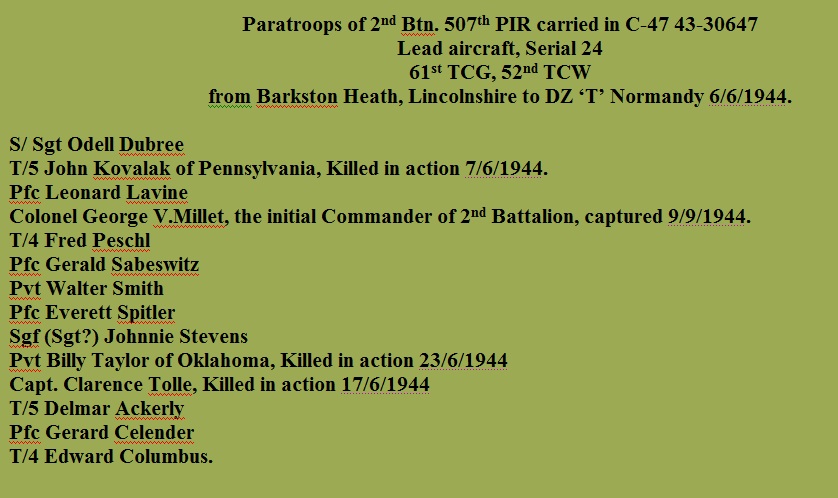
Travel with D-Day Squadron.
Virginia Ann travelled from her California home to Oxford-Waterbury Airport via Roswell and the Wright Brothers field at Dayton, Ohio. Her landing at Oxford at 14:55 on 17th May 2019 was more exciting than planned when she reportedly veered off the runway. No damage or injury to her 6 occupants was sustained. The following day, May 18th, Virginia Ann joined the New York City flypast. Departing with fellow D-Day Squadron members Flabob Express and D-Day Doll for Goose Bay on 19th, she arrived Narsarsuaq, Greenland on 22nd. after poor weather delayed some transit stages. The following day, 23rd, N62CC flew from Narsarsuaq to Reykjavik where some engine maintenance was carried-out. On 24th May, Virginia Ann began the long over-sea leg to Prestwick in Scotland, flying at 6000′ in clear weather, 9000′ in cloud. The last of the eight D-Day Squadron aircraft to arrive, Virginia Ann was on the ground around 19:30 in time to participate in the Prestwick photo evening. The following day, the eight Dakotas were on display at Prestwick. At the end of the weekend, Virginia Ann departed from Prestwick at 12:36 on Monday 27th May, arriving at Duxford at 14:24.
Virginia Ann remained at Duxford for the next few days and maintenance was carried-out prior to flying activities later in the week. On June 5th, she departed Duxford in the 26-strong Dakota echelon and was one of the twenty aircraft which dropped parachutists on the Normandy peninsula before landing at Caen Carpiquet. After the commemorations in Normandy on June 6th and successive days, Virginia Ann departed for Wiesbaden on 9th June along with other members of D-Day Squadron. The Air Day at Wiesbaden was thoroughly successful and N62CC then moved on to Nordholz when bad weather delayed flying to Fassberg. On June 13th, she took part in a flying display at Schleswig- Jagel, some 60 miles north of Hamburg as part of the commemoration of the Berlin Airlift. By 18th June, I believe Virginia Ann was keeping Placid Lassie company at Tannheim before departing for Venice. After her visit to Italy on June 21st, Virginia Ann returned to Duxford on June 23rd prior to heading for home. I have her recorded as being at Prestwick on June 26th, but she did drop in to visit the Stornoway Helicopter Coastguard base on June 27th for refuelling, so maybe Prestwick was missed-out going westwards. On June 28th, N62CC arrived at Reykjavik and, the following day, she departed for Goose Bay, Presque Isle and Geneseo, New York. A spell of rest was called for after the second Atlantic crossing and she remained at Geneseo for the airshow held between 12th and 14th July 2019. From there, it was on to Oshkosh for the 2019 Airventure air show on 27th and 28th July where she reunited with seven other D-Day Squadron Dakotas and close on a dozen other C-47s/ C-53s. Eventually, Virginia Ann made it home to Flabob Municipal Airport, California on August 7th 2019 at the end of a truly epic journey. Photos at various airfields visited can be found at a number of excellent websites via the links below:
Virginia Ann N62CC since 2019 Atlantic Crossing with D-Day Squadron
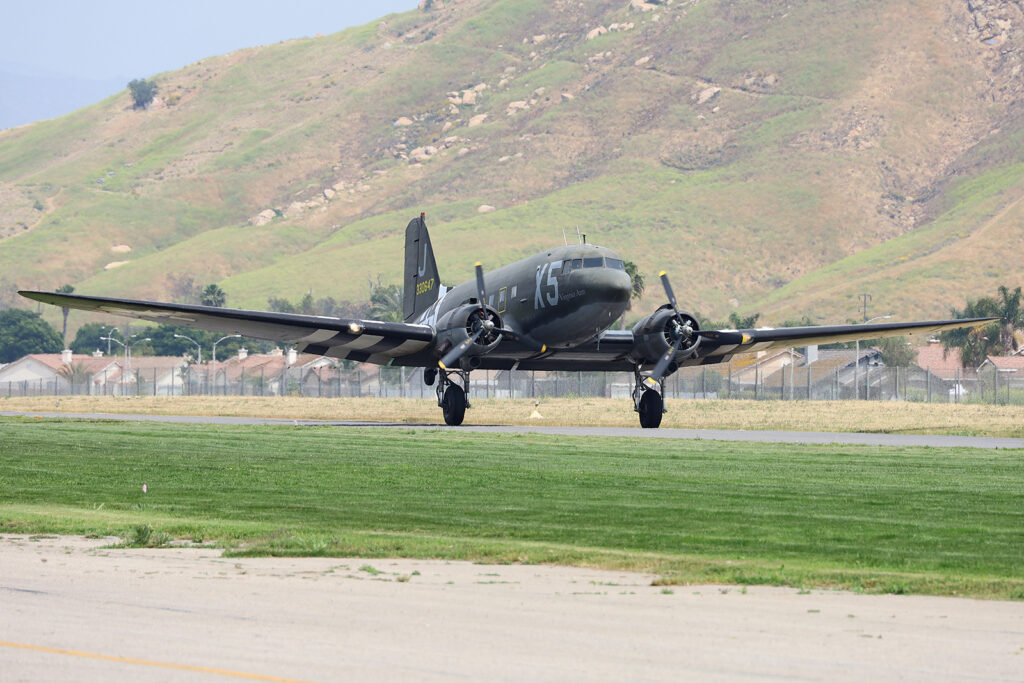
Virginia Ann is one of three D-Day Squadron 2019 campaign C-47s which spends a lot of time at Riverside, California. She lives alongside N103NA, ‘Flabob Express’ at Flabob Airport while ‘D-Day Doll’ is generally to be found at the adjacent Riverside Municipal Airport. Also at Flabob, currently as a static display, is the ex-Four Star C-47 N131FS now painted in post war USAF colours.
Under the ownership of Barry Fait, Virginia Ann continues to grace the local airshow circuit – although the 2024 D-Day Squadron flight to Europe wasn’t practicable. After the Spring start-up of her engines, she was seen most recently flying around the hills and valleys of Southern California on May 17th 2024.
Updated: June 7th 2024.
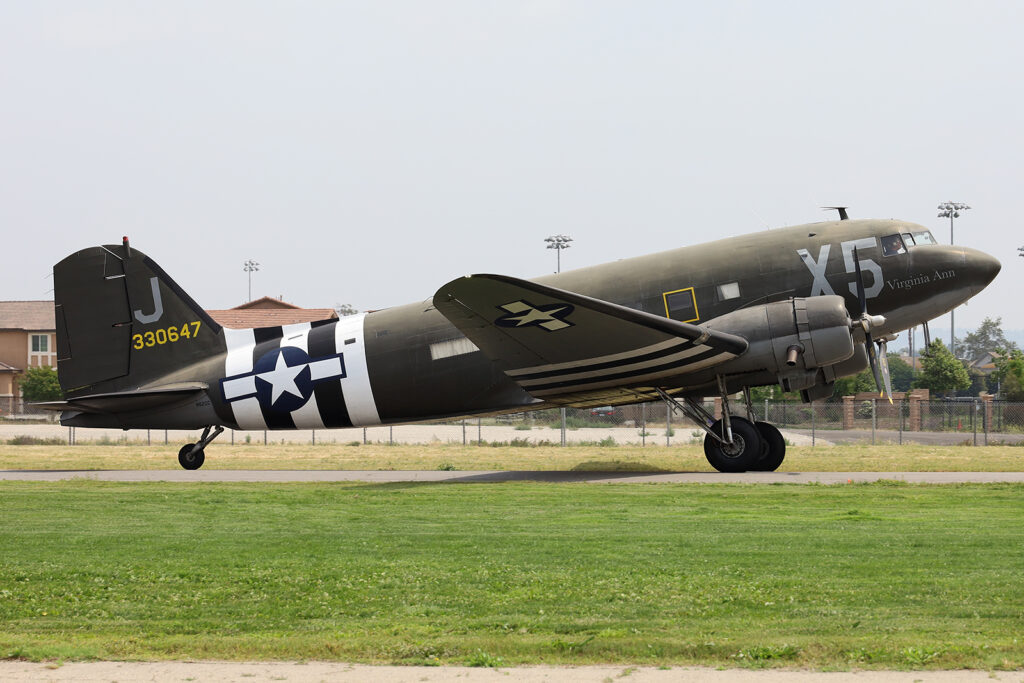
Hits: 1286
